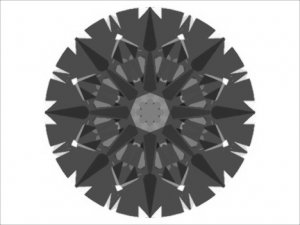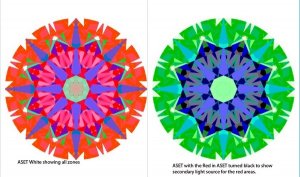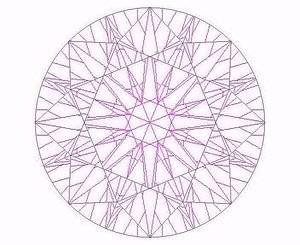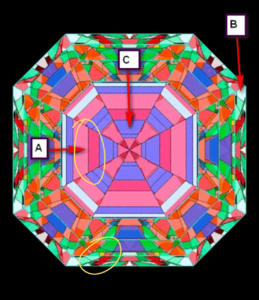- Joined
- Apr 8, 2014
- Messages
- 1,229
The angles are referenced from the stones girdle midpoint.I have a question about something that was said in the OP article regarding what the ASET colors mean, and I've seen it put this way many times.
"Green – Reflected light, not as intense as (red) direct light and of lower quality, representing the light return from the horizon to 45 degrees."
As I understand it, yes, green represents the sections of the stone which are returning light coming into the stone 0 to 45 degrees, where the 0 degree plane is parallel to the the plane of the viewer's eye (typically, for ASETs, that's also parallel to the stone's table). However, I don't see how green automatically means that light will be less intense and/or of lower quality. Isn't that dependent on the light source, its intensity and positional relationship to the stone?
ASET does not show intensity just direction.As for quality of light reflection, doesn't that have more to do with the color saturation of the green or red rather than that the area is green or red?
(Sorry, @Karl_K , but I'll likely forever tag you in anything remotely close to a technical question!)
The angles are referenced from the stones girdle midpoint.
ASET does not show intensity just direction.
Tag me anytime this stuff is fun!
Color mixing caused by areas of the diamond having multiple light paths.Thanks for that clarification.
I don't meant light source intensity, but reflective intensity of the stone. I'm looking for something to account for the pinks to reds and the light greens to emerald green, etc.
Yay!


Light leakage of less than ~2% which is in every MRB is enough to lighten the color in ASET white.Wouldn't light-path color (blue, green, red) "mixing" give you purples, yellow-browns, more blues, blue greens, etc.? What I notice in ASETs are gradients of a single color, which I'd assumed meant lesser reflectivity in those areas, or basically color mixing with white (leakage), so that in those areas with light green or pink, those areas are lined up to reflect red (or green), but are only reflecting them back partially due to varying degrees of leakage.

minor leakage present in every MRB which can be made worse by over bright back lights.So, in an ASET, what is going on, specifically, so that some greens and reds are washed out to pink or very light green while others are solid green, solid red? And if you've already answered, forgive me; I haven't understood.
Its complex.Speaking generally, then, for all shapes, a lighter red or light green in comparison to the robust reds and greens, is indicative of some slight leakage, likely imperceptible to the unaided eye, made more apparent by strong backlighting?
Wouldn't this mean those those sections of lighter, washed out color just aren't set up to be as reflective as those sections of more saturated color, allowing some of the backlighting to sneak through? Is it more a matter of the limitations of the material rather than design?


Correct.Or, is it something about that virtual facet is mixing with the backlight coming in from the pavilion?
I see many issues with this.I had a thought while thinking about this.
Has anyone every thought or tried to construct a self-lit ASET, where the outside of the ASET would not allow in light, but internally, the ASET cone would emit (adjustable) light consistent with the three color bands on a normal ASET scope? Adjustable, so we could experiment with altering the intensity of single color paths, or turning them off all together.
% of the light beam.I can't make out the meaning of the various %s, but roughly measuring that angle, I'd think the color of that area where the arrow is pointing would be red, reflecting light entering from that 70ish degree angle; meanwhile, the other end of that path would show blue, reflecting light entering from from close to 0 degrees.
Intensity of each light zone would have to be calibrated to get useful results.I agree it would cost more than the current ASET, but maybe not cost prohibitive for everyone.
When you say "calibrating", what do you mean? I'd think matching the angles and color proportions of the interior cone to those of the current ASET's interior cone would be easy. The engineering would just be from the interior wall of the cone out, where the lighting would be housed. A thick enough colored section of material with uniform diode placements to illuminate it doesn't seem difficult in theory.
I just wonder whether such a device would still give us the various color gradients of our individuals colors or whether the colors reflected would be more standard, red, blue, green. Plus, what would happen if you turned off the Red and left on the Green, or vice versa; I just think those results would be interesting to see and then explain, but maybe all that stuff has already been worked out some other way.
